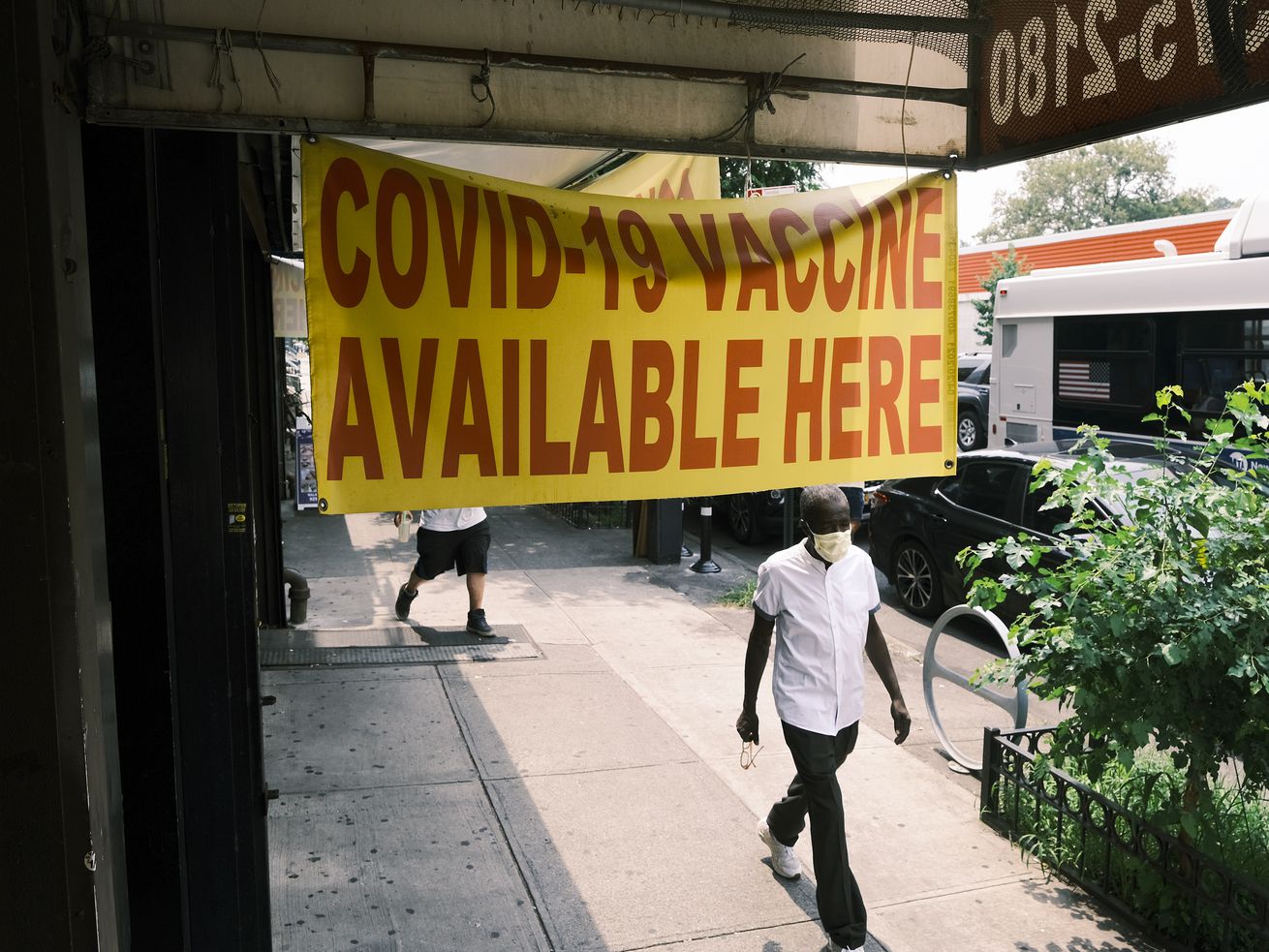Vaccines are the solution to Covid-19. Let’s make the most of them.
All of a sudden, it looks like masks may have to be put back on.
With the rise of the delta variant and a rapid increase in Covid-19 cases, the US Centers for Disease Control and Prevention is calling on vaccinated people to wear masks indoors again in places where the virus is quickly spreading. At least some school districts will likely require masks this fall. Local governments, from Massachusetts to California, are reviving mask mandates.
A year ago, requiring masks as cases spiked would have been an obviously smart decision. Mask mandates work, and for most of 2020, they were among the best methods we had to stop the spread of Covid-19. But masks were never meant to be the long-term solution; they were a stopgap until the US and the rest of the world could stamp out epidemics through vaccination.
Now those vaccines are here. And the changed circumstances of summer 2021 call for new approaches. Any entity thinking about a mask requirement — from private businesses to local, state, and federal governments — should consider mandating something else first: vaccination.
/cdn.vox-cdn.com/uploads/chorus_asset/file/22744259/GettyImages_1330417903_copy.jpg) Andrew Lichtenstein/Corbis via Getty Images
Andrew Lichtenstein/Corbis via Getty ImagesUnvaccinated people, whether they’re apathetic or resistant, are the reason the coronavirus remains a threat in the US. The country and everyone concerned about the rising case rate should do everything in their power to push these people to get a shot.
The federal government could require vaccination for its own employees, as President Joe Biden is reportedly considering, and offer incentives, financial or otherwise, for others to do the same. Local and state governments could require vaccines for their employees, health care workers, schools, and public spaces, from restaurants to museums. Even without any government support, private organizations could act alone, requiring vaccinations for their employees and, ultimately, proof of vaccination for anyone on their premises.
The US Department of Justice seemed to clear the way recently for vaccine mandates, declaring in a recent memo that “entities” can impose vaccine requirements for shots authorized under emergency use without full federal approval. And some government agencies, including New York City, California, and the US Department of Veteran Affairs, are now requiring public employees or health care workers to get vaccinated.
I’ve been talking to experts about mandating vaccines for months. Earlier this year, when I wrote about vaccine passports, many argued that mandates should only be tried as a last resort — we should try improving access and offering incentives first. Only if those options failed should we rely on the more drastic steps.
Well, we’re here. America has made the vaccines much more available to just about everyone who’s eligible. The nation has tried rewards, ranging from free beer to gift cards to a cash lottery, to nudge people to get a shot. Yet we’re stuck. Half of the US population still isn’t fully vaccinated.
It’s time to try that last resort.
Vaccine mandates work
France has historically been one of the more vaccine-skeptical countries in the West, and it’s struggled more than some of its peers to get people vaccinated. Two weeks ago, the country announced that it would require proof of vaccination for everyday activities, like restaurants and shopping centers. The news of the requirement led to a record rush for vaccine appointments, with 1.3 million people signing up in less than one day. (It also led to some protests.)
Israel has used “green passes,” proof of vaccination that’s required for everyday activities like restaurants and movie theaters, for as long as it’s been administering the vaccines. That requirement is cited as a key reason Israel has led much of the world in vaccination: More than two-thirds of its population has received at least one shot; more than 60 percent are fully vaccinated. (The US, by comparison, is less than 57 percent with at least one dose and below 50 percent fully vaccinated.) Israel recently reimposed some masking rules, but only after going hard on vaccination first.
/cdn.vox-cdn.com/uploads/chorus_asset/file/22744273/GettyImages_1231531557_copy.jpg) Jack Guez/AFP via Getty Images
Jack Guez/AFP via Getty ImagesIn the US, the Kaiser Family Foundation’s surveys have consistently found for months that about 20 percent of Americans are resistant to getting the vaccines. But even among these resisters, about 30 to 35 percent say they would get the shot if it was required. If a mandate would move even some of the most hardcore skeptics, then it would almost certainly boost vaccination rates across the country, also pushing the other 13 percent of the country who are still in “wait and see” or “as soon as possible” mode to get going.
In a follow-up interview, a 51-year-old man who said he would only get the vaccine if it was required told Kaiser he ultimately got it, and did so because he felt he had “limited options without it.” In New York, where he lives, the government has kept some restrictions for unvaccinated people, and employers have required the shot in some places as well.
None of this should be surprising. Vaccine mandates have been a part of American public health policy for decades, especially for health care workers and anyone attending school.
A 2019 review of the evidence on school mandates found that the requirements “appear largely associated with increased vaccination coverage” (while calling for better studies). And a 2015 review of the evidence on mandates in health care settings found they’re the most effective out of several options to encourage vaccination.
Meanwhile, the vaccination rate among American 2-year-olds for diseases like polio and measles — shots required for decades for public school attendance — surpasses 80 or even 90 percent.
Schools don’t require students to go through elaborate restrictions or rituals for these other diseases. They just require the vaccine. We can and should learn from that.
Universal vaccination would protect all of us
There’s also the less empirical case for requiring vaccination: It’s simply the right thing to do.
Based on all the evidence, the vaccines really work, including against the variants. Vaccinated people may still get infected by the coronavirus, leading to flu-like symptoms. But the vaccines nearly eliminate the risk of hospitalization and death — the real threat of Covid-19 — even with the variants.
The reason, then, that mask mandates are now coming into consideration is largely to protect unvaccinated people, who are truly at risk from the virus. As White House medical adviser Anthony Fauci declared in June, the Covid-19 epidemic in the US is really becoming the tale of “two Americas” — vaccinated and not.
A New York Times analysis in June found that places with more than 60 percent of their population vaccinated report about one-third of the cases as those with a lower vaccination rate of zero to 30 percent. And other data suggests that the current rise in coronavirus cases is almost entirely among the people who haven’t gotten vaccinated, with the new outbreaks hitting the low-vaccination states harder.
This presents a conundrum: Places that reinstate mask mandates are effectively asking vaccinated people to care more about unvaccinated people’s risk of Covid-19 than most of these unvaccinated people do (or else they’d get the vaccine).
There are important exceptions. Children under 12 are still unable to get the shot (and that will likely force mask mandates in K-6 schools this fall). The immunocompromised may not always get full protection from the vaccines. Yet the best evidence we have indicates these people would also be most protected if everyone who can get vaccinated did so, because it would reduce the spread of the virus.
The biggest hurdle to that kind of universal vaccination is no longer access. Vaccines are everywhere: I can, as I write this in Cincinnati, find appointments at multiple grocery stores and pharmacies in the next hour, including in some of the poorest neighborhoods, and appointments aren’t even needed in many of these places. The share of Americans who want to get vaccinated “as soon as possible” but have not is tiny: about 3 percent in June, according to the Kaiser Family Foundation’s surveys.
There’s more work to be done to make sure people have all of the information they need to get vaccinated and to actually access the shots. But the problem is no longer that people desperately want the vaccine and can’t get it; it’s that people need to be swayed to want it at all.
A mask mandate could even work against the vaccine campaign. Some research has found that people can be motivated to get vaccines with the promise that they’ll be able to stop masking up. As one vaccinated 52-year-old told the New York Times, “I just honestly got sick of wearing the mask. We had an event yesterday, and I had to wear it for five hours because I was around a lot of people. And I was sick of it.”
Requiring vaccinated people to keep masks removes an incentive for the shot.
And it doesn’t address the core problem: People who are eligible for the vaccine are still unvaccinated. That’s what needs to be fixed. If nothing else, all tools — up to and including mandates — should be used to move unvaccinated people before vaccinated people are asked to make more sacrifices.
A mandate could be a last resort — but it needs to be an option
For some of the population, a vaccine mandate would almost certainly produce a backlash. It could lead some of the resisters to harden in their refusal to get a vaccine, or polarize the US even further.
This is what some experts worry about. Jennifer Nuzzo, a senior scholar at the Johns Hopkins Center for Health Security, has told me, “You take someone who is generally uncomfortable but willing to have a conversation, and you make it about them and an infringement on their liberties, and then they wind up getting more hardline on their views about the vaccines than they otherwise would have been.”
It’s a genuine public health conundrum. A mandate needs to lead to more people getting the shot than otherwise would, not fewer. And while the Kaiser Family Foundation surveys suggest that mandates would lead to more people overall getting the shot across the country, that may not be true in every town, city, county, or state.
Policymakers can address this by moving slowly, at first requiring public employees, health care workers, and schools to get the vaccine before phasing in mandates to the rest of the population. It may help these will likely be local and state decisions, given that the Biden administration has repeatedly resisted setting up a green pass–like system in the US. Different local and state governments may make different decisions about which settings require vaccination. And mandates should be treated as a last resort: The cities and states that, for example, haven’t tried cash incentives for vaccination could try that first.
/cdn.vox-cdn.com/uploads/chorus_asset/file/22744291/GettyImages_1330950159_copy.jpg) Anna Moneymaker/Getty Images
Anna Moneymaker/Getty ImagesEven with all that, there may still be a backlash. Yet the mask mandates being discussed right now risk a backlash, too, in exchange for a much less permanent solution; many of the same people who refuse to get vaccinated are the same as those who most vehemently refuse to mask up. Ultimately, for cultural or political reasons, some places might not be able to impose a mandate of any kind.
But far more could than have tried so far, and far more should try. Even a patchwork system in which you need a vaccine to do some things in some places, but not everywhere to do everything, will push more people to get the shot than today’s reality, where you most likely don’t need a vaccine to do anything at all.
Yes, a vaccine mandate, like a mask mandate, infringes on a person’s ability to make their own personal health decisions.
But as Brown University School of Public Health dean Ashish Jha previously told me, “Freedom cuts in both directions.” If people’s resistance to getting vaccinated leads to more Covid-19 outbreaks and, worse, the rise of a variant that can overcome existing vaccines, the ensuing caution and restrictions would hinder people’s freedoms far more. That’s what we’re seeing right now as places consider adopting mask mandates again due to outbreaks caused by unvaccinated people.
To put the threat of Covid-19 behind us, people need to get vaccinated. As a country, the US has tried just about everything else in the toolbox. Before we go back to 2020’s policy ideas, we should make full use of the best tool we have in 2021.
Author: German Lopez
Read More



